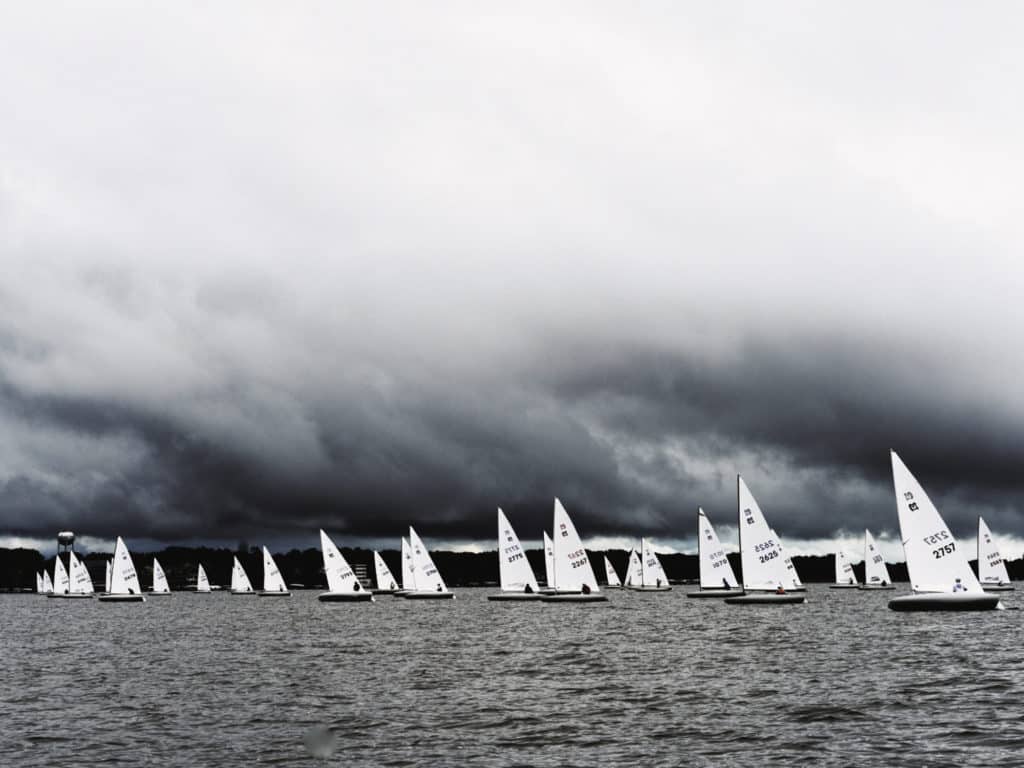
When Scott Harestad describes sailing MC Scows, his eyes light up with the expectation of a kid on Christmas morning. You can almost feel the exuberance. “The acceleration in the puffs is just amazing!” he says gesturing outward, his face slightly reddening with excitement and eyes widening like he’s suddenly been transported onto a wild reach on some distant lake. His speech quickens, and he shifts his weight from one foot to the other. “And,” quickly catching a breath, “you’re constantly working the controls—cunningham, vang and mainsheet—to keep it there.” Then he’s suddenly on dry land again and just as quickly asks, “Have you sailed one?”
I have, so he pivots to Jen Edney, our photographer, who is standing nearby.
“How about you? Ever sail an MC?”
And before Edney has a chance to finish saying she hasn’t, he’s at work, trying to set up a time and place to make it happen.
Harestad is no fly-by-night MC Scow proselytizer. He’s earned his stripes through 40 years of participation and is on his fourth boat. From Spring Lake, Michigan, Harestad travels a lot, living by the adage “you go to their regatta and they’ll come to yours.” And as current class president, he’s eager to tick off the latest class success stories to anyone who will listen. Recently, he notes, they have five active sailmakers and a New Jersey fleet that’s blossomed from five boats to 30 in a year and a half. And now, at the class’s 50th Anniversary National Championship held at Clear Lake, Iowa, where there’s 119 boats, is a class record.
Anniversary regattas are nothing new in the one-design sailing landscape, but only a few draw such big fleets. When that happens, it’s not just a testament to longevity, but also a barometer of the class’s future. The MC has come a long way from its first national championship, held in early October 1971 in Shreveport, Louisiana. That event—won by hull No. 10—drew a dozen sailors, all with wide-eyed optimism about the future of this new Melges-designed scow. Andy Burdick is the president of Melges Performance Sailboats and holder of a Tom Brady-like record of 12 MC national titles. He says: “It wasn’t until the 1980s and ‘90s that production numbers started to get really big—over 100 MCs a year. Lately, it’s averaged around 50 a year.”
Still, that’s a number most classes can only envy.
Part of the MC’s success lies with the Melges traveling road show, where a trailer would be loaded up at the factory in Zenda, Wisconsin, and the driver would be given marching orders not to come back until the trailer was empty. It worked. There are now more than 2,800 MCs, with 662 of them holding class memberships—up from 574 in 2020.
As another indicator of the class’s well-being, if you want a new boat, the going wait is three months. And good used boats are rare as hens’ teeth. In fact, at the championship’s Saturday-night annual meeting, Harestad pushed the idea that everyone should buy new boats so the market would get an injection of affordable used boats. The demand is certainly there, and the boats hold their value, so why not? Dan Allen from Clear Lake, who has a new boat on order, sold his boat right after the regatta for just a few hundred dollars less than he bought it for six years ago.
Designed as a scaled-down, simplified version of the C Scow, the MC (the “M” is for Melges) is basic: a three-stayed rig and only five sail controls—mainsheet, traveler, cunningham, outhaul and vang. It’s easy to transport on a small trailer and simple to rig. It’s the least expensive of the Melges scows and, because it’s not sailed flat, is easier to hike on than most dinghies. Consequently, the class continues to draw a lot of master sailors. Witness the 2020 Masters National Championship, which drew 109 boats, also held at Clear Lake.
The class, however, is doing well at attracting racers from the opposite end of the age spectrum. “Some of the kids coming out of the junior program seem to feel that this is an old person’s boat,” says Dan Quiram from Pewaukee Lake, “but then they try a C Scow, which takes a lot of strength, and quickly realize this is a great boat for them.”
More than a half-dozen youth skippers are sprinkled into the 50th anniversary fleet.
Conceived as a singlehander, MC sailors regularly bring a crew aboard, especially when the wind is above 10 knots. In fact, unless you’re well over 200 pounds, you probably need to have a crew to be competitive when the wind’s up. The ideal total weight in a breeze is 210 to 380, which means it works well for a lot of husband-wife and parent-child teams.
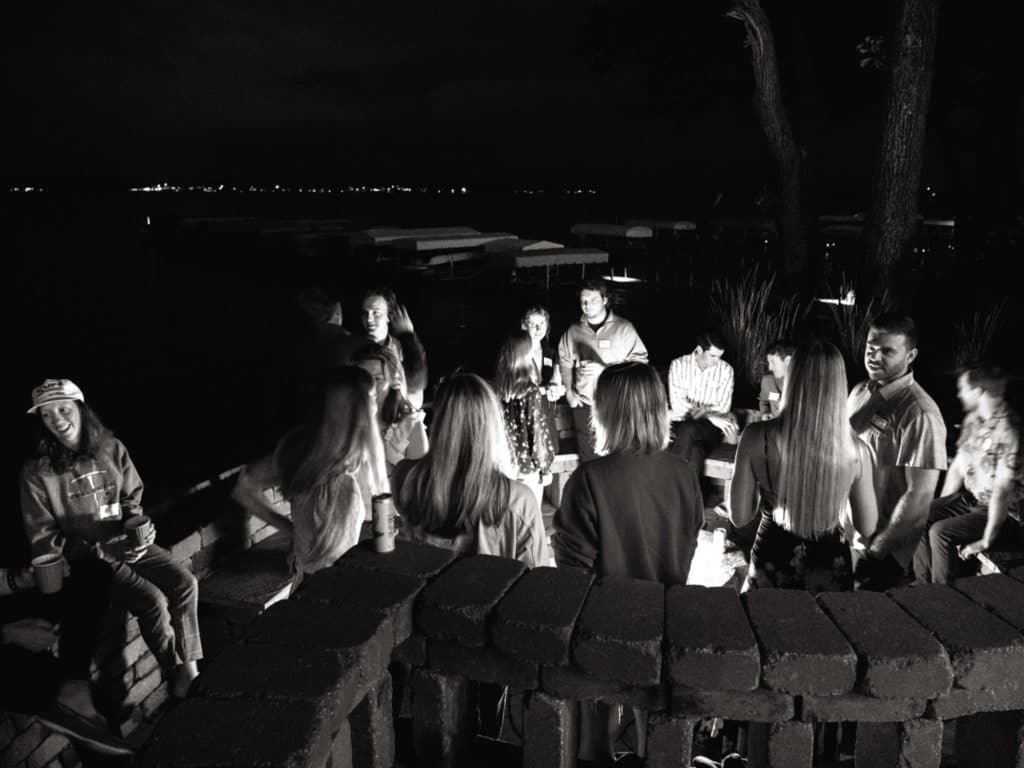
The crew option has also been a great promotional tool. “I can’t tell you the number of times I’ve taken people with me on the MC who’ve never sailed before because all they really have to do is switch sides when we tack or jibe,” Burdick says. “They can get involved as much as they like with the sail controls and boards. I’ve seen a lot of people get into the sport just because they’ve gone for that ride.”
One case in point is Annie Samis, a 14-year-old junior sailor from Chicago, whose background includes Optis and Lasers. Never having sailed an MC, she was convinced to put her name on the 2021 Nationals crew list and was paired with Richard Blake, from the Hoover Sailing Club in Ohio. She got a chance to first sail with him in the practice race, but it didn’t take her long to get hooked.
“It’s so much fun!” she gushes with the enthusiasm of a high-school cheerleader. Samis and Blake already have plans to sail in a future Nationals as well as at the Hoover SC. As a bonus, her name was drawn in the raffle at the Saturday-night party that produced five winners of new sails, one from each of the class’s sailmakers—not a bad way to enter the class. The five sailmakers donated the sails, and raffle proceeds went to Clear Lake Youth Sailing.
Although the controls are basic, the MC is a bit like a saxophone—easy to play, but difficult to play really well. Excellence can sometimes take years. Maybe that’s why some of the best in the fleet are those who’ve been at it the longest—those in the masters, grand masters and mega masters groups. Almost 70 percent of the 2021 Nationals fleet were masters.
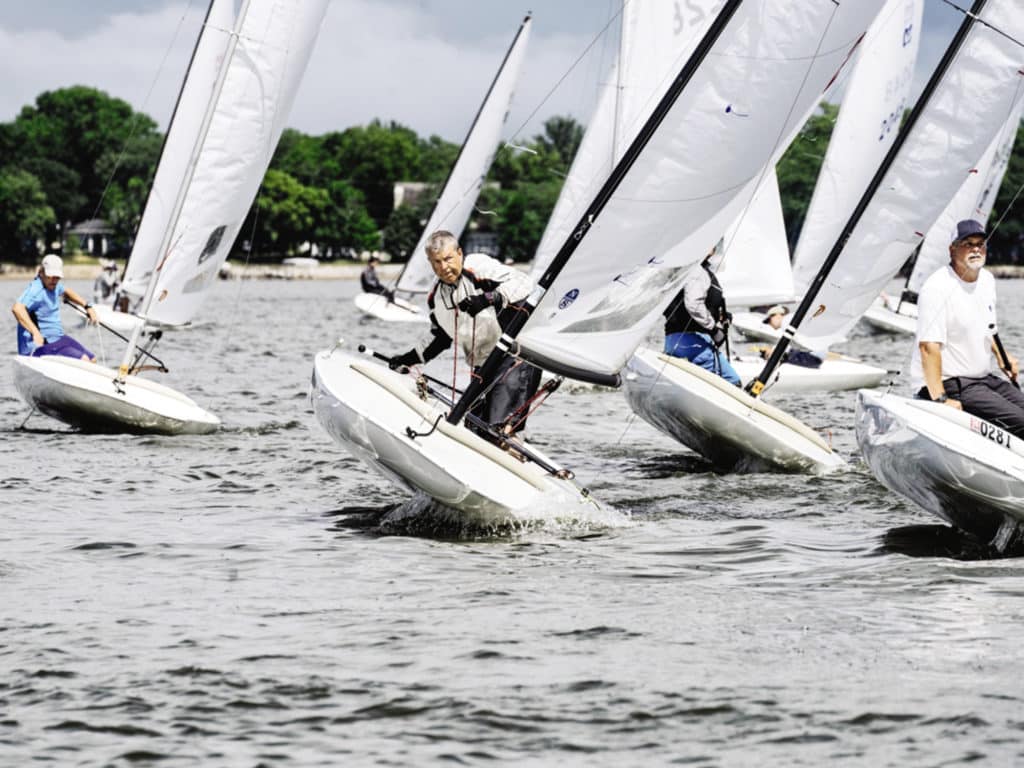
Quiram started racing MCs when he was 21, and at the time, he says, he thought to himself, “‘I hate those old masters bastards!’ Then I became a master, and I said, ‘I hate those old grand masters bastards!’ And now I’m an old grand master.”
There are also idiosyncrasies unique to scows. Former Finn sailor Andy Casy from Oklahoma says: “It’s challenging because you have a leeboard going out at one angle and the mast at another angle, and you have to get the right dynamics going to make it all work. You can have two boats in the same wind, and one will be 15 degrees higher than the other, just because that boat has everything working right.”
Matt Fisher points to the challenge of a blunt bow and big mainsail. “It can be a tough boat to sail downwind in a big breeze, as it’s easy to submarine the bow,” he says. “You have to go more by the lee than you’d think and really work to steer around the waves.”
Still, as Dan Wilson from Indianapolis points out, there’s a wide range of abilities at regattas. “No matter where you are,” he says, “you can find a group to race against at your level.”
The MC has one builder, Melges, which has been the case since the beginning, except for a period in the 1980s and ‘90s when Johnson Boatworks began building them, but it went out of business in 1998. Having one builder has added stability to the class, something highly valued in most one-designs.
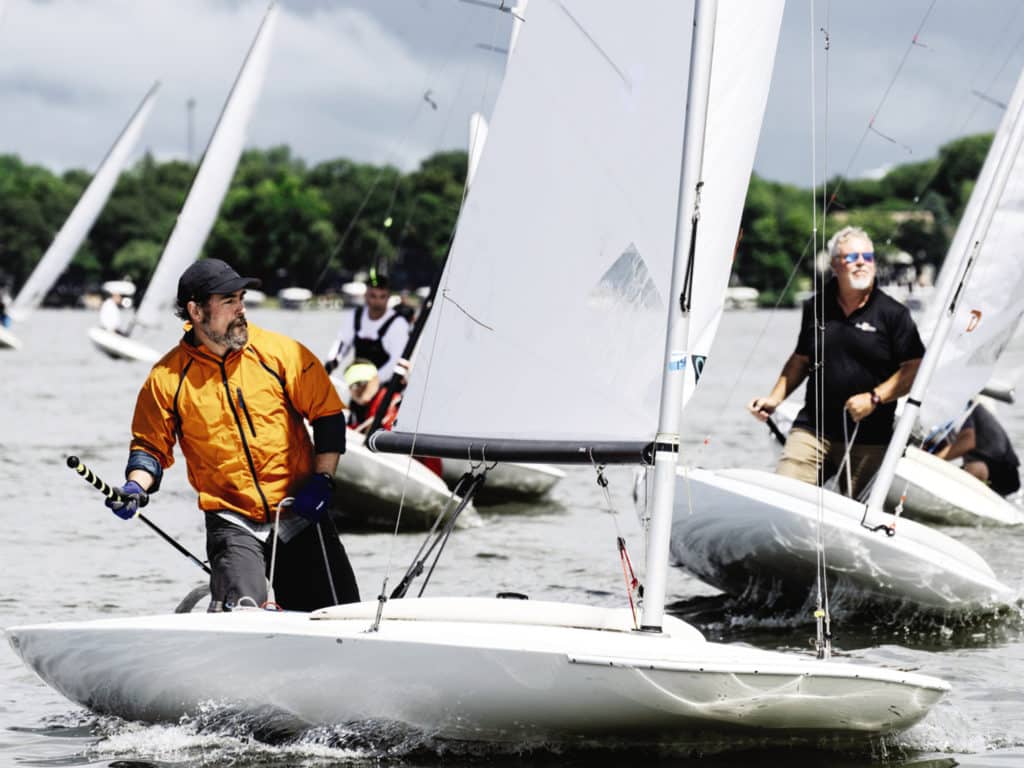
There have been subtle changes over the years, such as the addition of a mast-base pivot plate, which allows one person to raise the mast instead of two. And from around 2010 through 2017, Melges produced a sealed-cockpit version, in part to minimize the amount of water in the boat when capsized. The builder then went back to the open-cockpit layout but removed the aft deck, which, among other things, made it easier to roll and store the sail. “Melges has been good at responding to what we want,” Harestad says, “and that’s been a real plus.”
Admit it or not, there’s more to a regatta than just the racing. Iowa’s Clear Lake YC proved this over a three-day national championship that was never completed, thanks to a rotation of no wind, rain, severe winds and thunderstorms. On this particular weekend, sailboat racing throughout the Midwest encountered similar conditions. Up north, A Scows were skunked on the first day of their US Nationals on Wisconsin’s Pewaukee Lake, eventually getting in four races over the next two days, and Chicago fleets racing on Lake Michigan reported tornadoes. For the purely race-centric, the apocalypse was surely at hand.
But from a broader perspective, the MC Scow 50th Anniversary event demonstrated resiliency to uncooperative weather and the ability to still chalk up a win of sorts, presenting a model for how to do a lot with just a little. While the weather allowed completion of just one race (the class minimum is three for a championship), the emphasis Clear Lake YC had placed on the nonracing side was the regatta equivalent of a winning lotto ticket.
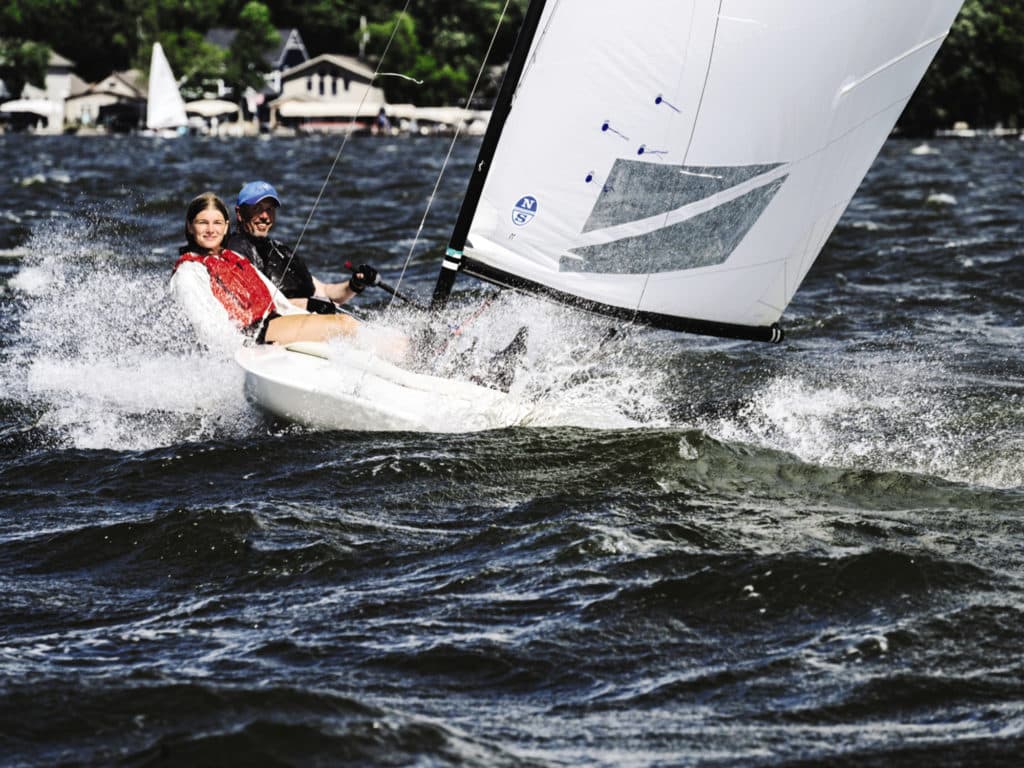
Understand that this is no large yacht club, neither in numbers nor size—the 150 members occupy a small building on the site of a former Jaycee’s bathhouse at the base of Main Street. The building blends in well with the lakefront, evoking a late 19th or early 20th century railroad station, complete with wide roof overhangs around the perimeter. Founded in 1935 by “Cookie” Cook and a few others, it’s on public property, which makes it accessible for junior sailing lessons. There’s one ramp and a single dock with three fingers. Membership is $170 a year. Juniors are free. That the club’s volunteers pulled off the logistics of managing 105 visiting boats plus the home boats is nothing short of remarkable. Certainly, there was a ton of work, but they take it all with a dose of Midwestern modesty.
“We started organizing this right after the masters championship here last September,” says Stu Oltrogge, the event’s co-chair, “so we had the highway basically already built.”
Oltrogge’s wife, Judy, recruited 55 volunteers to handle the onshore activities—meals, registration, etc.—while another 25 took care of launching, haul-out and spectator boats. That’s a considerable volunteer corps given the size of the membership.
Clear Lake is just over 5 miles long, and the racing area at the south end of the lake is 2 miles in diameter, with an average water depth of 12 feet. It’s unique in that the water level is 100 feet higher than the surrounding area, which, in normal times, should increase the chances of good winds. Apart from sailing, Clear Lake is most known for the Surf Ballroom, where, in 1959, Buddy Holly, Ritchie Valens and the Big Bopper last performed before their plane crashed a few miles outside of town. While those musicians put Clear Lake on the map, it’s a vibrant, iconic Midwestern town with lots of activities every week, ranging from concerts at the lakeside band shell, to boat tours on a stern-wheeler, to farmers markets on Main Street.
There was also an intentional effort by Clear Lake YC to keep this event “small town.” “We decided we wanted to put groups of folks all around the lake,” says Mark Tesar, Oltrogge’s co-chair counterpart, “having them stay with host families or at an Airbnb.” Such a move was in part a muted response to lingering pandemic concerns, but also just a large dose of Iowan hospitality. The result was a handful of encampments of sorts. For instance, 13 Michigan sailors stayed at the unique “Pyramid House” along the lake’s north shore, a crew that included three national champions.
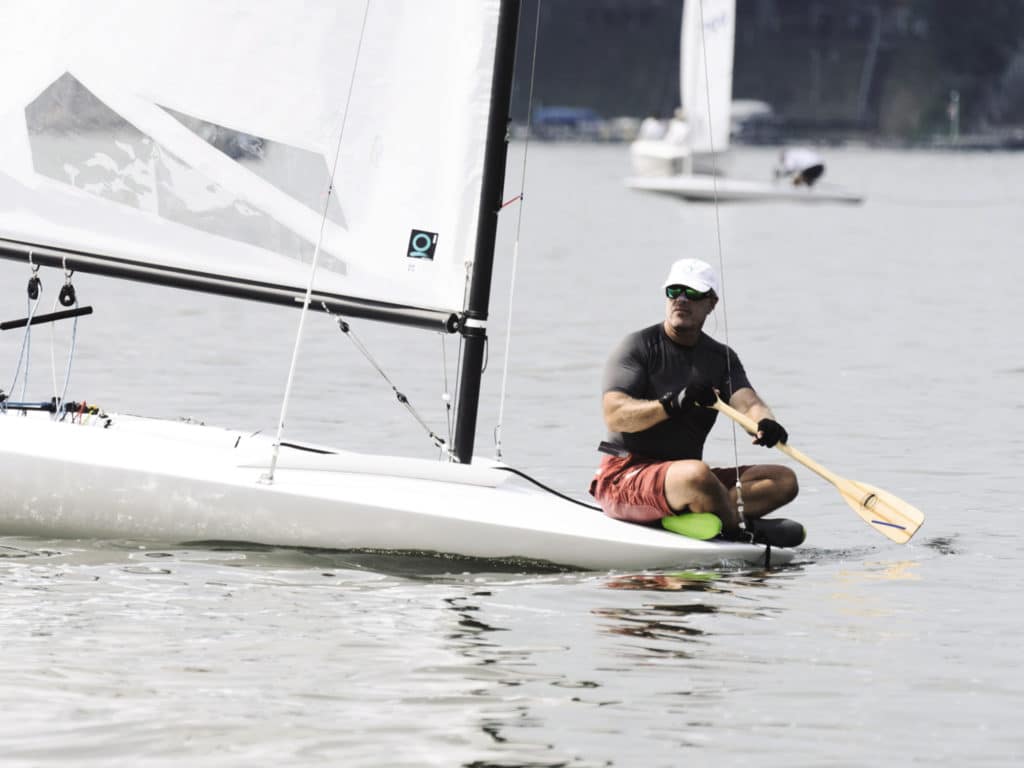
And then there was “the Compound,” where I was lucky enough to land a spot. I’m not sure whether it was a group of three houses based around three docks full of scows or whether it was three docks full of scows based around three houses. Either way, Mark Tesar, his brother Todd, and Mr. and Mrs. Oltrogge opened up their homes to MC sailors and made it available as a base for other boats. With plenty of food, beverages and shade on the porches, it would be tough to find a nicer place to hang out when the wind doesn’t materialize. With 17 MC Scows in front of their houses, there were more one-designs than you might see in front of a lot of YCs.
With visiting as well as local boats in the water and on vacant hoists along their docks, one could be sailing in less than 10 minutes and efficiently to the race area. Even better, with the racing area so close at hand, box lunches were available each morning at Clear Lake YC for people to take to their lodgings, and the plan was to sail a couple of races in the morning, come in for lunch, then sail an afternoon race. It was all very civilized.
Each private home, like most along any inland lake, has the requisite lakeside deck ringed with chairs and chaise-style lounges, with coolers readily at hand, and those became the hangouts during nonracing times, which meant they got a lot of use at this year’s event.
No doubt, the MC 50th Nationals will go down in class history as the regatta that wasn’t. Yet it was an opportunity for those who hadn’t seen each other since pre-pandemic days to reconnect—a reunion of sorts. So, it certainly was a regatta for the sailors looking to visit after a year of COVID-19 social denial. For Todd Tesar, it all felt normal. “We usually travel to a lot of the lakes around here and see the same guys all the time,” he says. “We stay at their homes; they stay at ours; we go to their weddings.”
Cam McNeil, who decisively won the event’s one and only race, says, “Despite the lack of races, it was still great to see old friends and meet new people.”
And that really is what this particular national championship is all about—gathering with friends, in honor of a beloved boat that loves you back.









